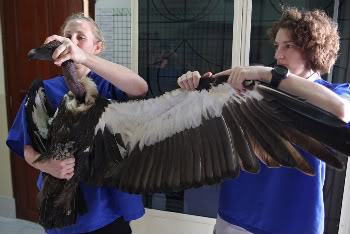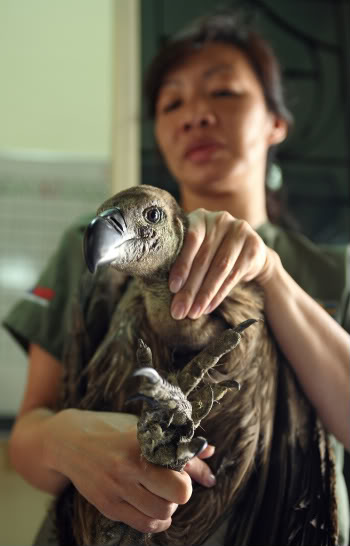|
|
Seven critically-endangered white-rumped vultures were found dead in Cambodia after feeding on the corpse of a poisoned buffalo. Two survivors however were also apart of the group. An adult and a juvenile that had fed on the poisoned buffalo were sick but alive. The pair was sent to a veterinary clinic in Phnom Penh to be cared for by staff from the Wildlife Conservation Society (WCS) and the Angkor Centre for Conservation of Biodiversity (ACCB).
The adult responded quickly to treatment and after being tagged for later identification was rereleased into the wild. The juvenile vulture is still being treated.
 WCS veterinarian Dr. Priscilla Joyner (right) and bird bander Helen Ward (left) examine one of the white-rumped vultures Photo credit: Allan Michaud.  WCS conservationist Angela Yang holds a rare-white rumped vulture, one of two birds that survived a poisoning incident in Cambodia’s Stung Treng province. Photo credit: Allan Michaud. |
“Vulture populations across Asia have plummeted,” said Hugo Rainey, WCS Technical Advisor to the Cambodia Vulture Conservation Project. “Every bird that we can save is important not only for vulture species, but for the ecosystems that rely on these birds as critical scavengers.”
Considered one of the most abundant birds of prey in the world at one time, the white-rumped vulture experienced precipitous declines beginning in the 1990s largely due to the anti-inflammatory cattle drug diclofenac. The drug proved effective in cattle but caused renal failure and mortality in any vulture that fed on the cow corpses which still retained the drug. Populations of white-rumped vultures dropped a staggering 95 percent and have yet to recover.
Cambodia is one of the last strongholds for the species. However, even here the white-rumped vulture is not without threats—for example feeding on a wild buffalo which had been poisoned by hunters. Fortunately the vulture is being monitored closely in Cambodia, which led to the rescue of at least one individual.
WCS is a member of the Cambodia Vulture Conservation Project, which was established the country by the government and several NGOS in 2004 to save the ailing species.
Related articles
Seeking out the world’s rarest and most endangered birds
(02/02/2009)
For an evolutionary biologist there is no conservation group whose work is more exciting than EDGE, a program developed by the Zoological Society of London (ZSL). Unique in the conservation world, EDGE chooses the species to focus on based on a combination of their threat of extinction and evolutionary distinctness. Katrina Fellerman, an evolutionary biologist herself and the EDGE birds’ coordinator, describes the organization as one that focuses on species, which “to put it bluntly, if lost, there would be nothing like them left in the world today”. Explaining further Fellerman says “We use evolutionary distinctiveness (ED) as a species-specific measure of the relative evolutionary value of species – it is a way of apportioning conservation value according to a species’ phylogenetic position. Species with few or no close relatives on the ‘tree of life’ have the highest ED scores.”
Drug use blamed as vulture population crashes 99% in India and Pakistan
(09/09/2008)
Captive breeding programs are not large enough to ensure the oriental white-rumped vulture’s survival, reports a new study in Biological Conservation.
Photos of surgery on an injured red-tailed hawk
(08/01/2008)
Dr. Paul Calle, Director of Wildlife Health Center at the Wildlife Conservation Society’s Bronx Zoo headquarters, and Cornell University resident Dr. Maren Connolly examine a red-tailed hawk found unable to fly by a park ranger in Rockland County.
Birds face higher risk of extinction than conventionally thought
(07/14/2008)
Birds may face higher risk of extinction than conventionally thought, says a bird ecology and conservation expert from Stanford University. Dr. Cagan H. Sekercioglu, a senior research scientist at Stanford and head of the world’s largest tropical bird radio tracking project, estimates that 15 percent of world’s 10,000 bird species will go extinct or be committed to extinction by 2100 if necessary conservation measures are not taken. While birds are one of the least threatened of any major group of organisms, Sekercioglu believes that worst-case climate change, habitat loss, and other factors could conspire to double this proportion by the end of the century. As dire as this sounds, Sekercioglu says that many threatened birds are rarer than we think and nearly 80 percent of land birds predicted to go extinct from climate change are not currently considered threatened with extinction, suggesting that species loss may be far worse than previously imagined. At particular risk are marine species and specialists in mountain habitats.
conservation success story: birds stage dramatic recovery in Cambodia
(04/03/2008)
According to a report released today by the Wildlife conservation Society (WCS), several species of rare waterbirds from Cambodia’s famed Tonle Sap region have staged remarkable comebacks, thanks to a project involving a single team of park rangers to provide 24-hour protection to breeding colonies. The project pioneered a novel approach: employing former hunters and egg collectors to protect and monitor the colonies, thereby guaranteeing the active involvement of local communities in the initiative.